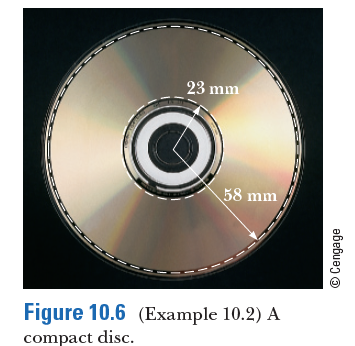Despite the availability of music in digital form, the compact disc, or CD, remains a popular format for music and data. On a CD (as shown), audio information is stored digitally in a series of pits and flat areas on the surface of the disc. The alternations between pits and flat areas on the surface represent binary ones and zeros to be read by the CD player and converted back to sound waves. The pits and flat areas are detected by a system consisting of a laser and lenses. The length of a string of ones and zeros representing one piece of information is the same everywhere on the disc, whether the information is near the center of the disc or near its outer edge. So that this length of ones and zeros always passes by the laser–lens system in the same time interval, the tangential speed of the disc surface at the location of the lens must be constant. According to Equation 10.10, the angular speed must therefore vary as the laser–lens system moves radially along the disc. In a typical CD player, the constant speed of the surface at the point of the laser–lens system is 1.3 m/s. (A) Find the angular speed of the disc in revolutions per minute when information is being read from the innermost first track (r = 23 mm) and the outermost final track (r = 58 mm). (B) The maximum playing time of a standard music disc is 74 min and 33 s. How many revolutions does the disc make during that time? (c) What is the


Trending now
This is a popular solution!
Step by step
Solved in 6 steps with 6 images







